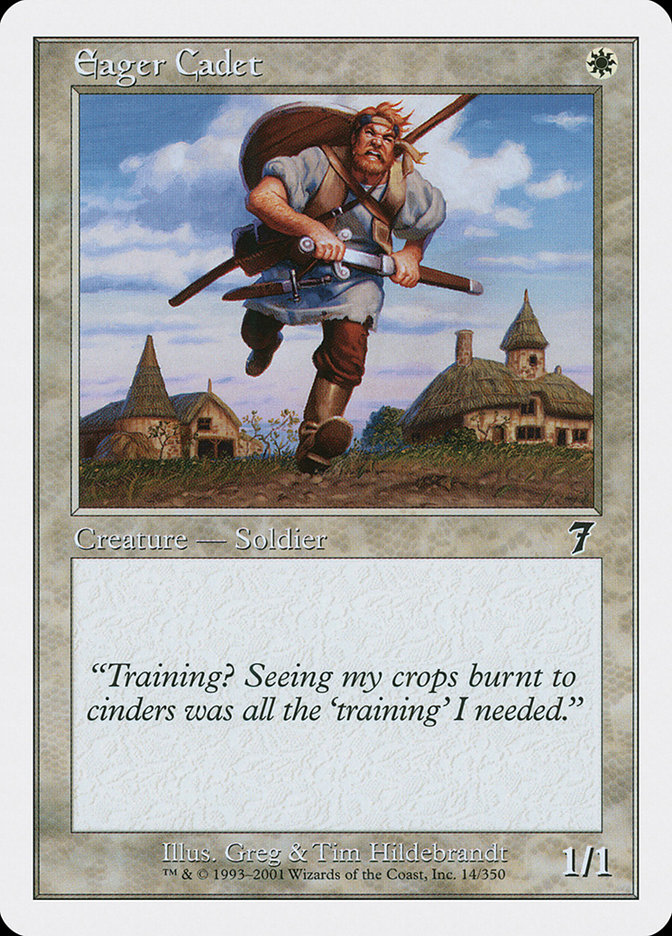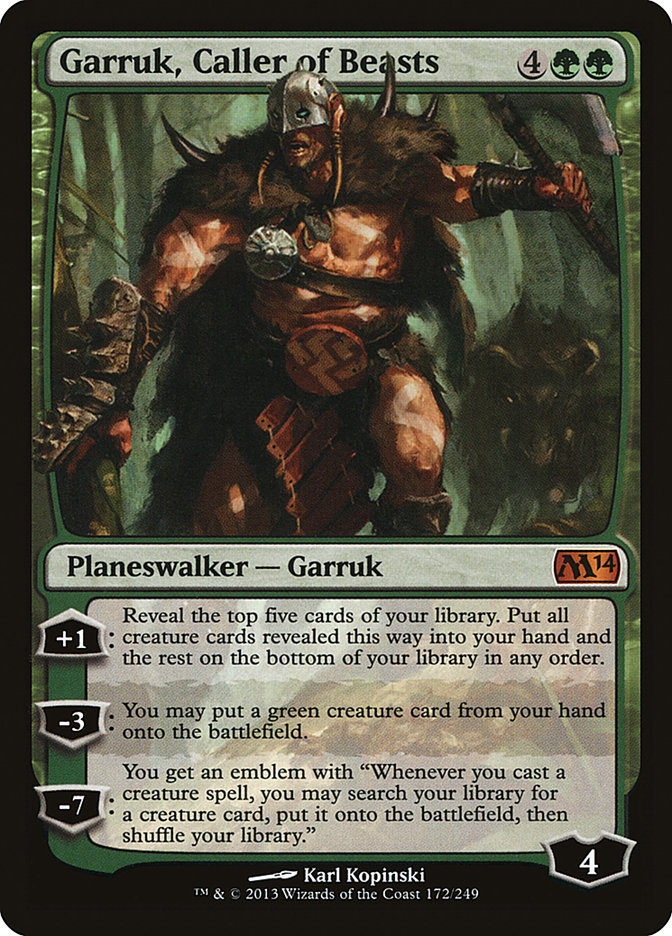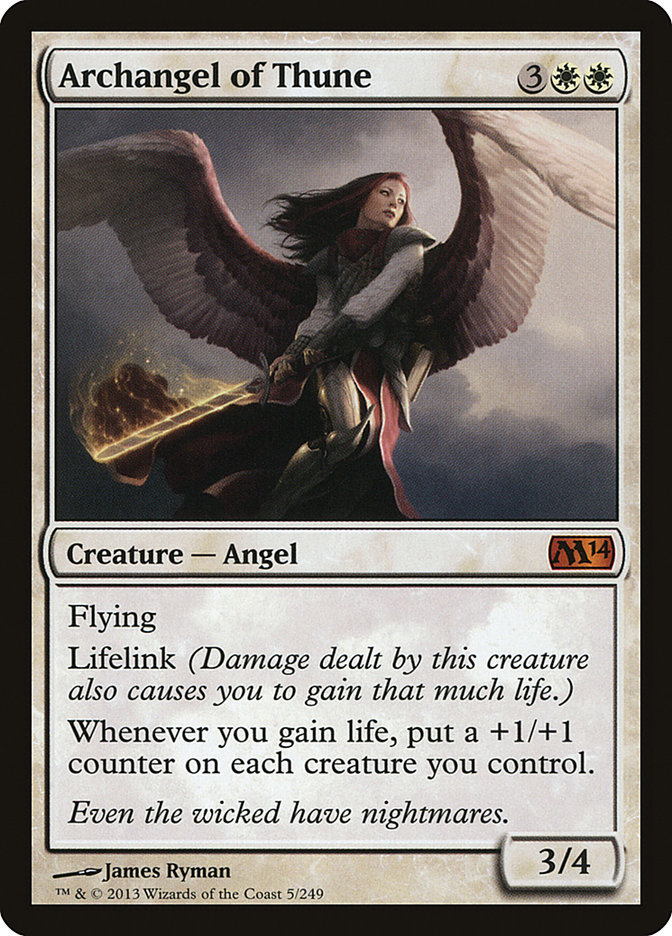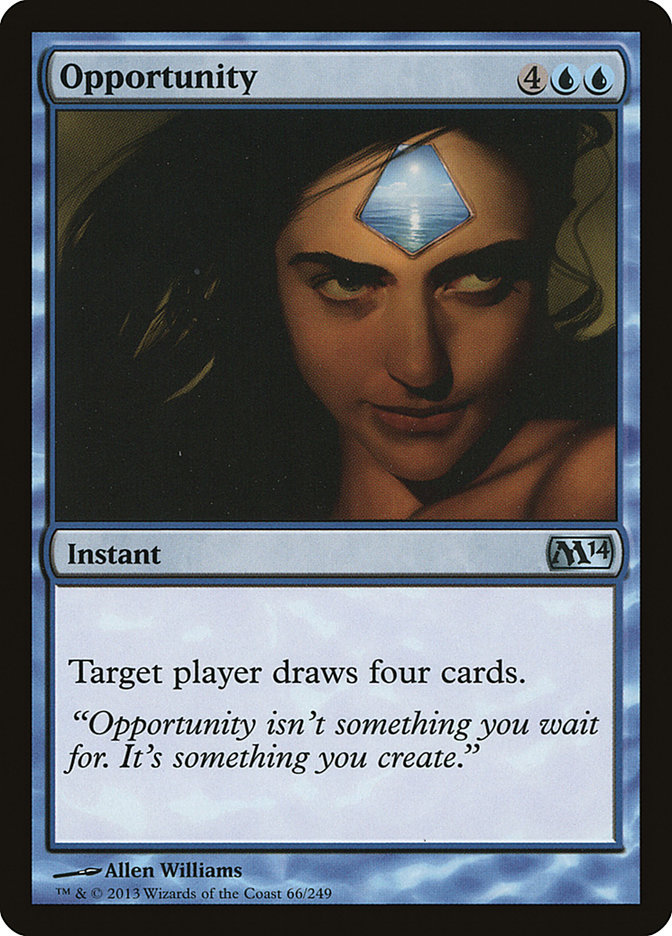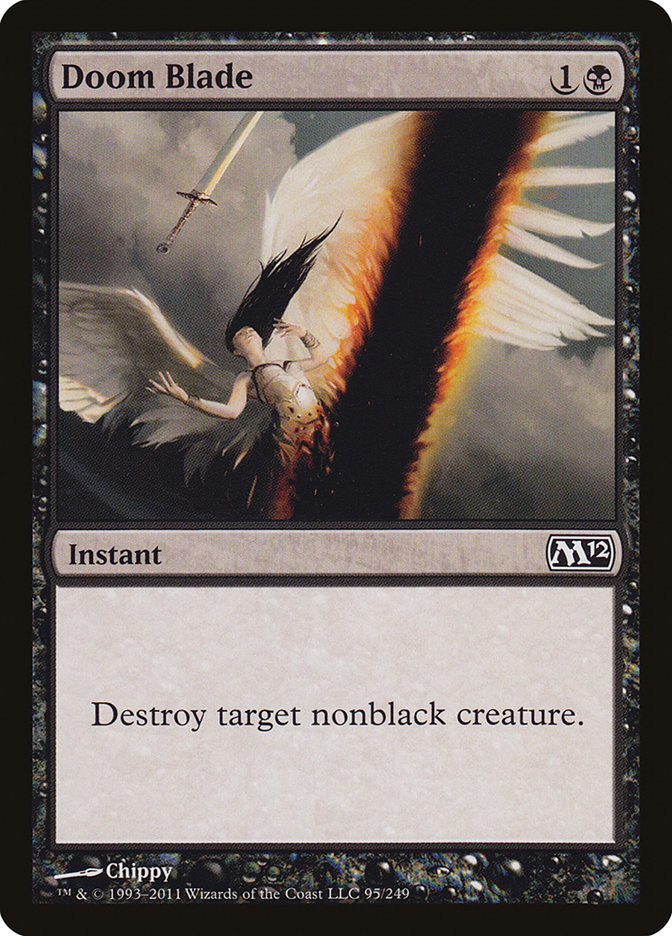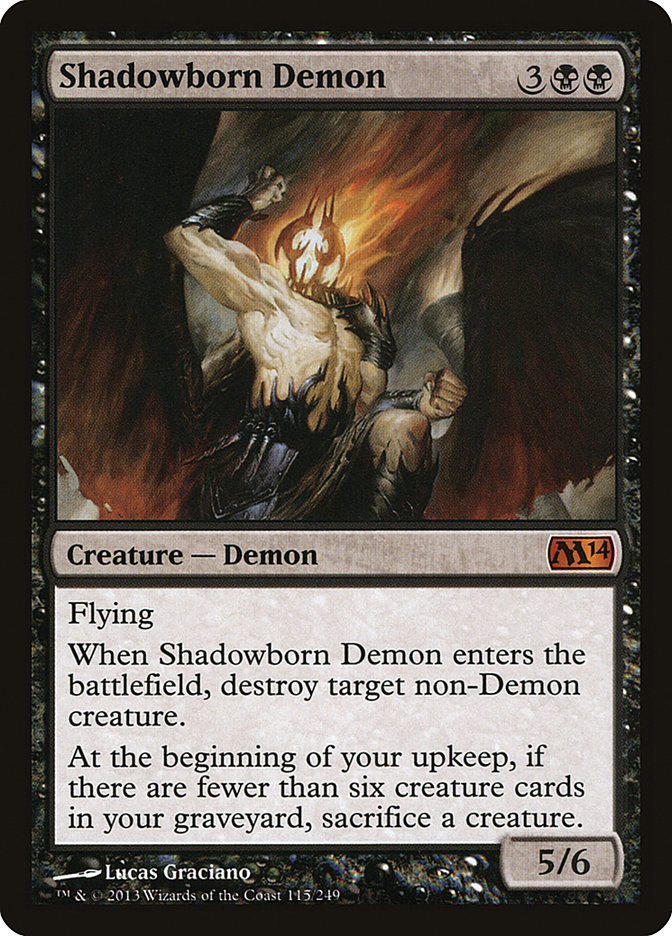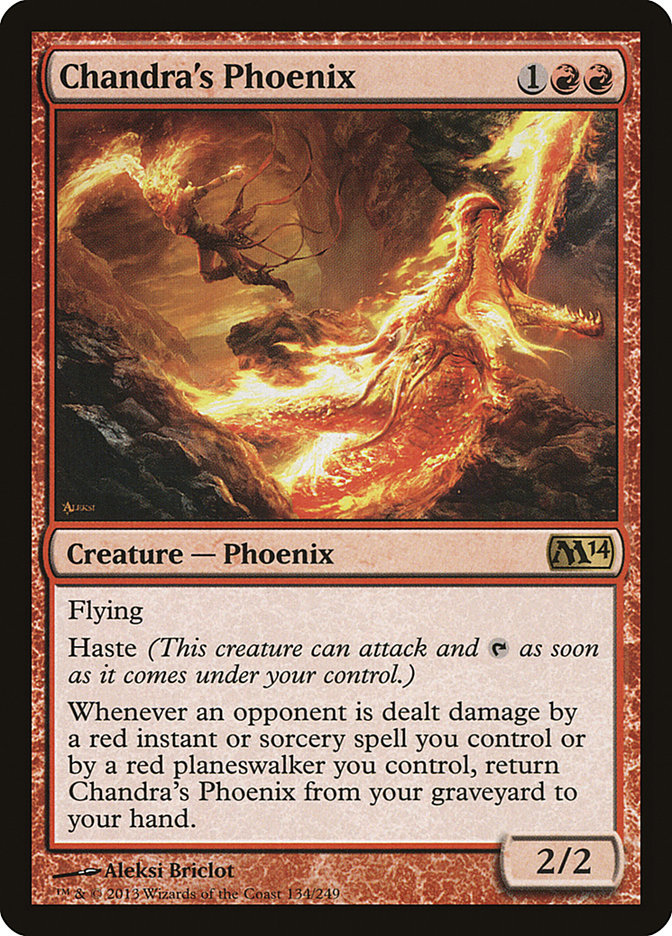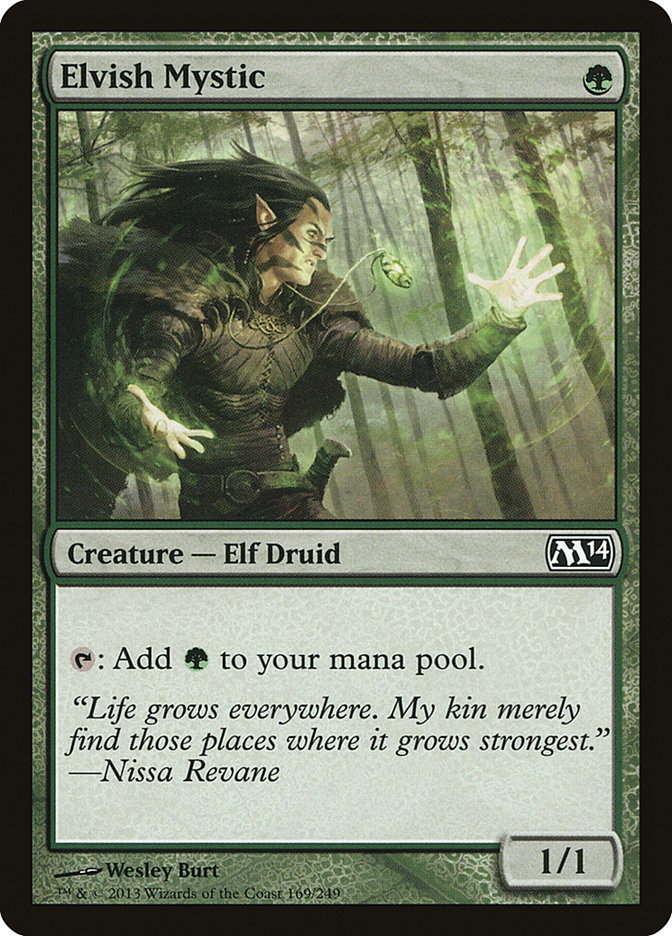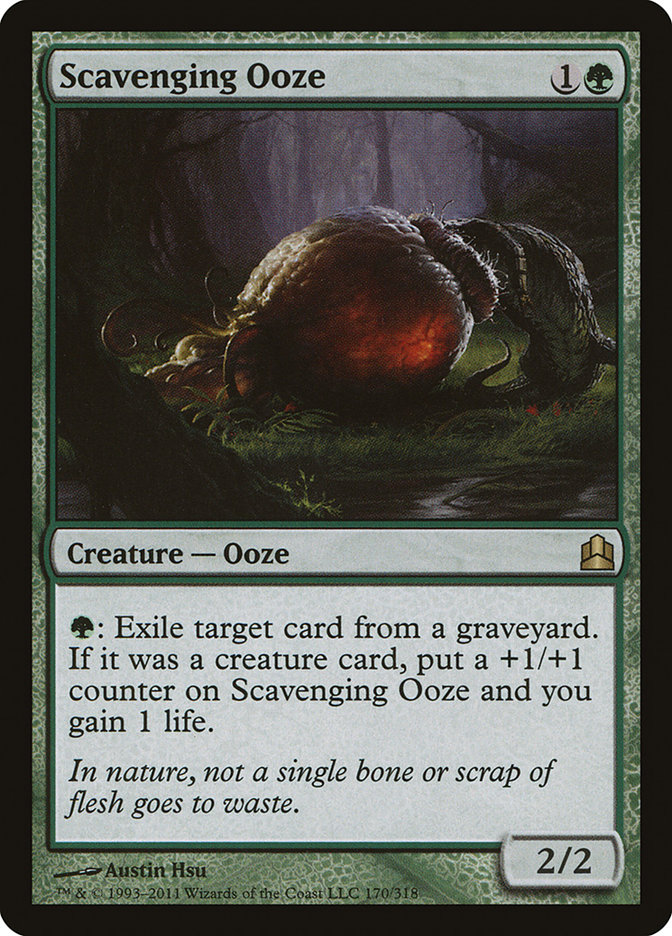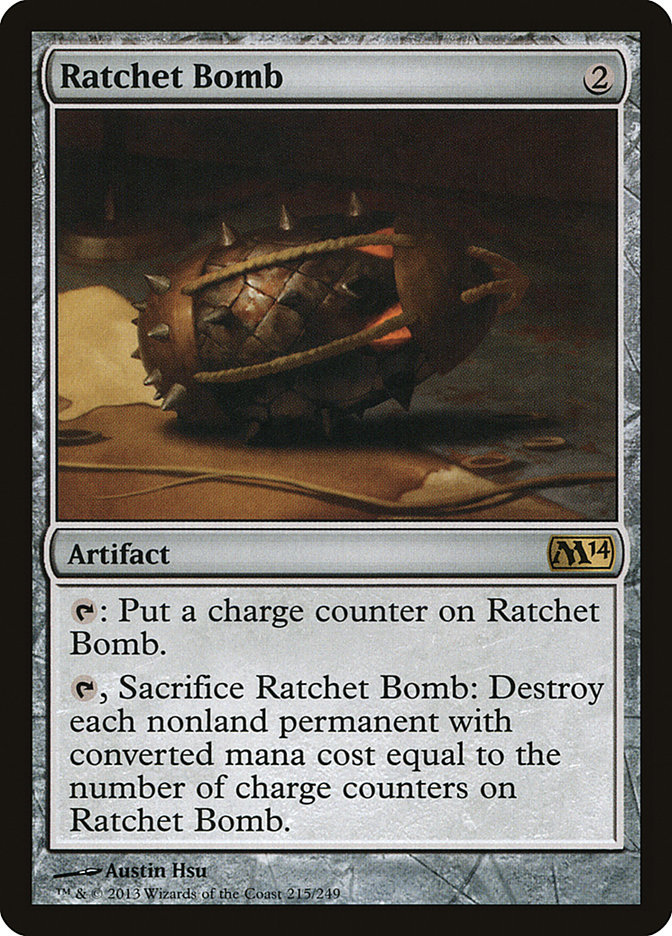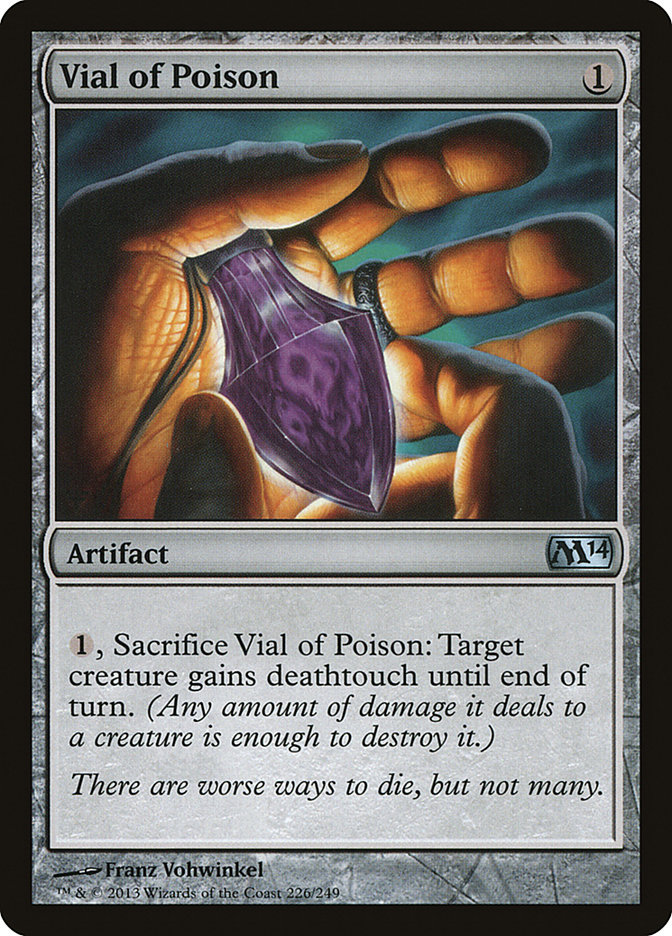Another summer. Another boring core set.
Well, except this time, we get some new planeswalkers. I guess that’s pretty cool. And there are sweet mythics. Good rares abound. Powerful uncommons are actually present. Alright, so maybe it’s not so bad after all… And I actually saved the best for last. M14 boasts some random commons of mixed power level designed essentially for Limited. Can you say wow?!
So maybe it’s not actually a boring core set? Maybe M14 is pretty nifty after all.
M14 is probably the most excited I’ve been for a core set since they announced Eager Cadet was triumphantly returning in Seventh Edition. Let’s just say I was a bit too…what’s the word…ah yes, excited to hear my sixth favorite 1/1 for one was back in action.
Traditionally, core sets have been lacking in power level compared to a "real" set. That doesn’t feel like the case in M14. Even the commons and uncommons feel very much Constructed playable as opposed to the typical fare of a few powerful rares and mythics and then the best generic removal spells really being the only cards from core sets that see play.
M13 had some good ones in Flinthoof Boar, Augur of Bolas, Arbor Elf, and Farseek, but M14 feels stronger yet. In M12, it felt like there was a huge clash between the Titan cycle and everything else. The Titans and Phantasmal Image were by and far more powerful than anything else; there was a huge drop-off to any other Constructed playables from the set. I’m glad to see the direction that M14 has taken seems to smooth out the power level and offer a lot of niche, fun, situationally relevant and yet still powerful cards.
The first card fits that bill perfectly. It’s niche, looks extremely fun, and yet still seems brutally powerful. There has been a lot of debate about whether this card will actually see any serious Constructed play. Putting aside any biases that may result from my raging man crush on this character, I personally think this card is definitely Constructed playable, and I’m pretty excited to try to figure out the right shell to abuse him in.
Garruk, Something Beast Related Since Apparently That’s All He Cares About
Or as I like to refer to him, Garruk, Baller of Beasts. Pick up the phone; it’s Garruk on the line. Caller status.
I have high hopes that Garruk can make a dramatic entrance into the Standard scene, so let’s take a gander at how his abilities can potentially lead his stampede into playability.
Before I extol his numerous virtues, I’d like to first quell the common naysays about him.
First up: he costs too much at six mana. As I mentioned on Twitter, costing six mana never stopped Sorin Markov from seeing fringe tournament play both times he was Standard legal. Sorin was usually a miser’s one-of in a few control decks, but he actually was the centerpiece of the B/W Sorin’s Vengeance Control deck that was very popular and successful on Magic Online last spring.
I think Garruk is abstractly more powerful than Sorin Markov. Sorin’s abilities are more consistent. You know what you’re getting every time you activate a Sorin, but Garruk makes up for that by having a much higher top-end power level. The +1 ability can draw three-plus cards, and the -3 ability is capable of ending the game on the spot with the right threats.
For the less fortunate of us, the +1 puts three lands and two other copies of Garruk on the bottom of your deck, and the -3 threatens to put either an Avacyn’s Pilgrim or Arbor Elf into play. Your choice. Let’s not dwell on that though. Focus! Focus on the upside!
Garruk also happens to be in the same color as Elvish Mystic, Arbor Elf, Avacyn’s Pilgrim, Farseek, Borderland Ranger, and Elvish Archdruid. Green doesn’t lack in playable acceleration, and most of those cards are also creatures, which also happen to interact very favorably with Garruk.
Secondly: he cannot protect himself. While it’s true that this Garruk lacks the traditional protection aspect that all three previous Garruks’ possessed by virtue of being able to create blockers, Garruk, Caller of Beasts is actually not left defenseless. His -3 ability the turn he is played allows you to conveniently place a blocker directly into play, say perhaps a Thragtusk, to shut down your opponent’s attacks or at the very least make it less profitable for them to finish him off.
Garruk can also play the same kind of role that Jace, Architect of Thought can sometimes play where you play him and draw a few cards and your opponent still has to waste a turn killing him. The following turn you get to untap with a few more options in hand, and your opponent hasn’t progressed their board that much since they had to waste time killing Jace. Garruk can +1 and draw a few creatures, and your opponent still has to dedicate five damage to killing him. If the creatures you are drawing are things like Thragtusk, they are left in a dilemma where they can’t really ignore the Garruk and try to race you, but by attacking Garruk they are putting you in a spot where Thragtusk can run away with the game.
But enough about refuting why he shouldn’t see play.
How about a little bit about why we actually should be playing him in our decks? It takes more than simply arguing against downsides to make a card actually have enough upside to play.
The upside in this case is Craterhoof Behemoth. Craterhoof is one of the best big green creatures that has ever been printed, and it just so happens that for a brief few months he will be legal in Standard alongside Garruk, Caller of Beasts. The two were meant to be.
Garruk’s +1 helps draw you into Craterhoof Behemoth. His -3 can get around Craterhoof’s restrictive mana cost and cheat him directly into play. Assuming you have literally anything else in play, the will be game over. Something as simple as an Arbor Elf, an Avacyn’s Pilgrim, and a Somberwald Sage means Craterhoof represents 23 trampling damage. Ouch.
There is another creature in Standard that also seems very good with Garruk’s -3 ability: Prime Speaker Zegana! Garruk’s -3 can cheat a Prime Speaker Zegana into play and let you draw a bunch of cards. Then you can use all of your untapped lands to actually cast the cards you’ve drawn off of Garruk. It just so happens that Prime Speaker Zegana actually got a lot better with M14 anyway because of the rule change regarding legendary creatures. Now you can play a second copy of Prime Speaker, have it be huge because of the first copy, and choose to keep the bigger one in play rather than have both die like they did under the old rules.
Here’s a sample decklist:
Creatures (32)
- 4 Elvish Archdruid
- 4 Arbor Elf
- 2 Avacyn's Pilgrim
- 4 Restoration Angel
- 3 Craterhoof Behemoth
- 4 Thragtusk
- 4 Loxodon Smiter
- 3 Prime Speaker Zegana
- 4 Elvish Mystic
Planeswalkers (4)
Lands (20)
Spells (4)
- 4 Forest

Another option is to pair Garruk with red. It could be pure R/G, but Naya and RUG also seem like appealing options. This pairing gives access to cards like Domri Rade alongside some powerful top-end beaters like Ruric Thar, the Unbowed; Gruul Ragebeast; and the big nasty himself, Borborygmos Enraged. Red also gives access to Huntmaster of the Fells and Ghor-Clan Rampager if desired. Garruk’s +1 hitting a few Ghor-Clan Rampagers could quickly spell game over for your opponent.
One thing I really love about Garruk, Caller of Beasts is that the kind of strategy he excels in is one with a bunch of acceleration to play him early and big finishers to close the game once he sticks. This makes previously near-unplayed cards with high power levels like Gruul Ragebeast, Sylvan Primordial, and even something as awesome as Elderscale Wurm very appealing to play with. Honestly, it’s just fun to play those cards. I can’t wait to do it.
Some other cards to consider with Garruk are Trostani’s Summoner, Wolfir Silverheart, Soul of the Harvest, Armada Wurm, and Progenitor Mimic. Really, the sky is the limit here. Or perhaps it isn’t since none of these creatures can even jump,* let alone fly.
The ground is the limit. Can you beat the ground assault?
Archangel of Thune
I actually love this card about as much as I love Garruk. I think this card will see Modern play since it offers another infinite combo for Birthing Pod decks. With Spike Feeder and Archangel of Thune, you can gain infinite life and make every creature that isn’t Spike Feeder grow infinitely large. With Archangel of Thune, a sacrifice outlet, and a Kitchen Finks, you can do the same thing. Archangel of Thune makes Birds of Paradise look like Marit Lage.
While those same combos don’t exist in Standard (and probably for the best), I still believe this card could be an extremely powerful player in Standard. In particular, I’m looking to play the card alongside two cards that I believe combo very well with it: Blood Artist and Scavenging Ooze.
Every time Blood Artist triggers with the Archangel in play, you get what amounts to a free Gavony Township activation. Thanks to cards like Doomed Traveler, Young Wolf, and Cartel Aristocrat, it’s very easy to set up these triggers. I could see Archangel fitting very neatly into a B/W Tokens shell or even the current Junk Aristocrats shell. I don’t even want to think about the kind of things that can happen with an Archangel of Thune; Mikaeus, the Lunarch; and Blood Artist in play. Or maybe I do. Maybe it’s all I want to think about.
Scavenging Ooze also offers a lot of awesome synergy with Archangel of Thune. For the cost of a single green mana and a creature in the graveyard, Scavenging Ooze will trigger the Archangel. It just so happens that Scavenging Ooze is also a very powerful maindeck playable card in the current Standard format. Scavenging Ooze shuts down undying and neuters the most powerful draws from the Junk Reanimator deck by ripping apart their graveyard.
Even beyond the powerful and repeatable synergies with Archangel of Thune alongside Blood Artist and Scavenging Ooze, I think the card simply pairs very well with a high number of cards that see play in the current Standard format.
There are so many cards in Standard right now that offer incidental life gain alongside other powerful effects. Every time Obzedat comes into play. Every time you cast Thragtusk. Every time you blink Centaur Healer. Every time Huntmaster of the Fells flips…Vampire Nighthawk deals combat damage…Sorin Vampires deal combat damage…Deathrite Shaman activates to remove a creature.
Hell, every time the Archangel itself deals combat damage, the ability will trigger.
Trostani, Selesnya’s Voice, Archangel of Thune, and Ooze Flux, anyone?
Trigger. Trigger. Trigger.
I have a new three-step process for Standard: play Archangel of Thune. Gain life. Bring dice.
Xathrid Necromancer
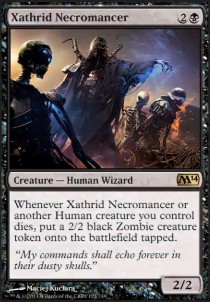
This is one of those cards that seems innocuous at first but can end up being a completely dominant powerhouse in Constructed. Not many people saw Cartel Aristocrat being a huge player in Standard, but it’s one of the defining creatures right now. If Cartel Aristocrat, a creature that thrives on sacrificing other creatures, can be one of the scariest two-drops in the format, then surely Xathrid Necromancer can be playable.
I think Xathrid Necromancer can fit very nicely into a B/W Human/Token shell. Xathrid Necromancer makes tokens and works well with Humans. Conveniently, there are a few other cards that share a similar vision. Gather the Townsfolk and Increasing Devotion both generate large amounts of tokens that are also Human. I am imagining a deck that looks like the following:
4 Isolated Chapel
4 Godless Shrine
4 Mutavault
5 Plains
6 Swamp
4 Doomed Traveler
4 Cartel Aristocrat
2 Bloodthrone Vampire
4 Blood Artist
3 Gather the Townsfolk
4 Lingering Souls
4 Skirsdag High Priest
4 Xathrid Necromancer
4 Tragic Slip
3 Sorin, Lord of Innistrad
1 Falkenrath Noble
With all of the sacrifice effects and the sheer number of tokens to sacrifice, it’s possible that a deck like this wants access to even more Falkenrath Nobles simply as extra copies of Blood Artist. It’s also possible that there could be a deck that uses Archangel of Thune, Blood Artist, and Xathrid Necromancer to generate very large amounts of very large tokens all while giving your opponent the old drain and…pain [Editor’s Note: Close one there, BBD.] treatment from Blood Artist.
Those three cards are the main ones that I see really being powerful archetype-defining cards in Standard. Beyond that, though, I think M14 offers a number of excellent role players that will surely see play in the upcoming year. I want to briefly hit on some of those as well.
Banisher Priest
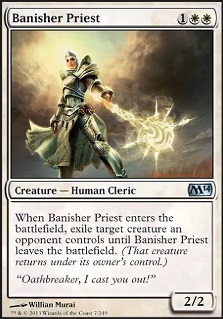
Banisher Priest is the fixed Fiend Hunter. Instead of situations where you can set up Restoration Angel or Cloudshift or sacrifice shenanigans to ensure that a creature is exiled permanently, with Banisher Priest it’s going to come back regardless.
I think this card may end up seeing more play than Fiend Hunter, however, simply because being a 2/2 is more relevant than a 1/3 for the style of decks that are typically playing this card. Junk Reanimator is a deck that prefers a 1/3 because it can block cards like Rakdos Cackler, Burning-Tree Emissary, and Voice of Resurgence without giving them their creature back, but decks like the old U/W Humans deck and Naya Blitz will greatly prefer having a 2/2 body that is a more potent threat on offense, and those decks are generally the ones where it has seen play.
Celestial Flare
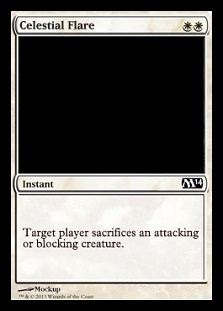
Decks like Naya now have an answer for Invisible Stalker and Geist of Saint Traft outside of just trying to race them successfully, which isn’t always a winning plan. Dispense Justice served a similar role at one point, and Celestial Flare is cheaper, although it’s more restrictive to cast.
When playing with cards like this, there is one important tip to always keep in your playbook. If your opponent tries to get tricky by doing something like also sending in an Avacyn’s Pilgrim along with their Invisible Stalker to prevent you from being able to Celestial Flare the Stalker, you can get tricky back yourself. If you block and kill the Pilgrim, you can then cast Celestial Flare in the End of Combat step. The Invisible Stalker is still considered an attacking creature, and without Avacyn’s Pilgrim in play anymore, they have to sacrifice the Stalker. Boom.
Opportunity
This gives decks like Grixis a way to actually keep up with Sphinx’s Revelation. While Opportunity is far less versatile—you can only cast it at six mana and you can’t gain life from it, which is one of the most important aspects of Revelation—it’s still going to be close enough in power level often enough to give Grixis a fighting chance.
Dark Prophecy
I don’t actually think this card will see any play. Decks like Junk Aristocrats don’t generally have time to try to set up this card, and the mana cost is extremely restrictive to a deck playing Temple Garden, Sunpetal Grove, and Gavony Township. It’s possible that there is a black deck with Blood Artist, Xathrid Necromancer, and sacrifice outlets that wants this as an engine piece, but that deck would need to be nearly mono-black in order to support the mana cost. If Dark Prophecy cost 1BB, I think it would see play, but as it stands I’m not sure it’ll ever find the support.
Doom Blade
Doom Blade is typically a less restrictive piece of removal than cards like Ultimate Price and Abrupt Decay, both which have seen a good deal of play since their printing. I expect this to become a default staple in decks like Jund, Esper, and most other black decks. I’m still desperately waiting for them to print the eventual Dome Blade. 1BR: Destroy target nonblack creature and deal 3 damage to its controller. Until that point, I guess I have to just settle for good old-fashioned Doom Blade.
Shadowborn Demon
This card feels borderline playable to me. The upside is that it’s a 5/6 flying Shriekmaw, which is absurdly good, but the drawback is actually relevant for once. The decks that can most abuse or tolerate the drawback aren’t generally looking for a five-mana effect like this; they would rather have a card like Tragic Slip. Even a deck like Junk Reanimator rarely has six creatures in the graveyard to turn off the ability, and that deck can’t generally afford to sacrifice a creature every turn.
With that being said, there is potential for abuse in sacrificing the Demon and casting Unburial Rites on it over and over again.
Chandra’s Phoenix
As a Caw-Blade player, Chandra’s Phoenix was a huge thorn in my side from the red decks when it was around the first time. It was by far the most annoying card to play against. The residual pressure and card advantage it provided was often good enough to grind out Caw-Blade, the grindiest of decks. The combination Chandra’s Phoenix had with cards like Searing Blaze to kill a creature, deal damage to a player, and bring it back were hard to play against.
Searing Blaze doesn’t exist anymore, but Flames of the Firebrand does and accomplishes much of the same goal. Pillar of Flame will probably keep this card from seeing play immediately, but I wouldn’t be surprised if we see a lot of Chandra’s pesky little friend after Pillar rotates out.
Elvish Mystic
This card improves a lot of current decks. In certain decks, it is an upgrade to both Arbor Elf and Avacyn’s Pilgrim. Pilgrim tapping for white is harmful in a lot of situations, and Arbor Elf’s drawback of sometimes being a 1/1 with no abilities (besides untapping your opponent’s Forests—it is a legal play!) is relevant. I expect Elvish Mystic to immediately jump into a number of existing archetypes, and it’s possible that new archetypes will even be able to spawn thanks to having access to twelve one-drop accelerants.
Scavenging Ooze
I wrote about this card when talking about Archangel of Thune, but I will basically say again that I expect this to see a lot of play. It shuts down flashback, graveyard synergies, undying, Deathrite Shaman, Junk Reanimator’s primary game plan, and can even just grow to be the biggest creature in play in grindy creature matchups. Gaining a few points of life here and there can also be very relevant against hyperaggressive decks.
At least until Innistrad block rotates, I expect to see a large amount of Scavenging Oozes in play.
Ratchet Bomb
I always hated playing this card when it was legal before. It was often slow and clunky, and while it could deal with any problem, it was rarely the best way to do so. With that being said, it’s a powerful card and can put a check on a number of strategies, such as an abundance of one-drops or a reliance on creature tokens. I wouldn’t be surprised at all if Ratchet Bomb flows in and out of popularity much like it did the first time it was around.
Mutavault
Mutavault is an extremely powerful card that saw a ton of play the first time it was legal. Right now, there aren’t a lot of decks that can take advantage of it, as much of the format is defined by three-color decks playing restrictive cards of each color and too many colorless lands can throw that off. I am sure that there will be some decks that make use of the card if nothing else as just a 2/2 manland, which is powerful in its own right.
Between Mutavault and Door of Destinies being reprinted, I expect that Theros is going to be a tribal block, so the stock of this card should drastically shoot up when Theros hits.
Vial of Poison
Format-breaking combo with Wasteland Viper.
Are there any cards you think are going to be serious contenders once M14 goes live? Do you have any sweet deck ideas for post-M14 Standard? I’d love to take a look at them.
As for myself, I will be probably be focusing my time trying to figure out the best way to play Garruk, Caller of Beasts or Archangel of Thune since those cards both seem like a lot of fun and are exactly the kind of cards I love to play. I just want to do awesome things.
As it would probably be wrong for me to write my first article about M14 without talking at all about Slivers, I’ll leave you with one of my favorite Mogg children’s rhymes my mother used to tell me when I was a kid: "Slivers are evil and Slivers are sly, and if you get eaten then no one will cry."
That always made me feel better right before going sleep.
Thanks for reading,
@BraunDuinIt in the vast and uncharted Twittersphere
BBD on the finite and fully charted Magic Onlinesphere
*When I pitched the movie White Men Can’t Borborygmos to a few Hollywood producers, they immediately shot the idea down, promptly escorted me out of their offices, and then tried to shoot me down in the parking lot for having even suggested it. Thankfully, I was able to evade their errant shots. In fact, my escape from their parking lot is the foundation for a based-on-a-true-story movie I am looking to produce now. The working title is White Men Can Dodge.

